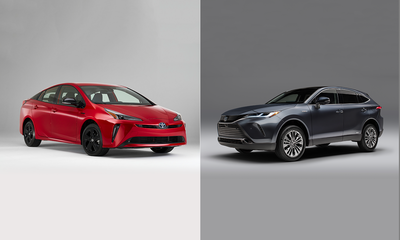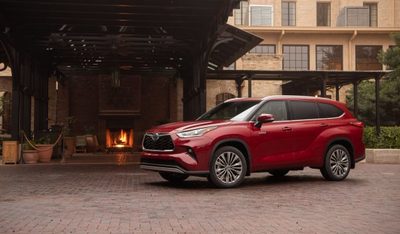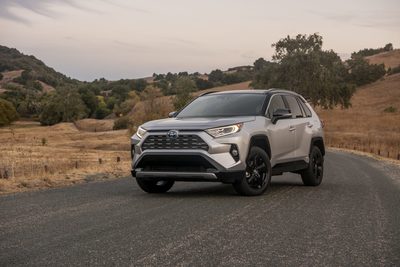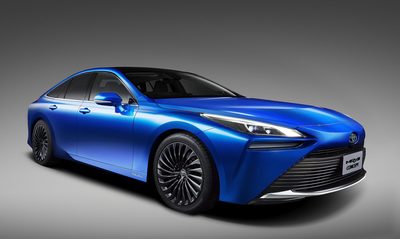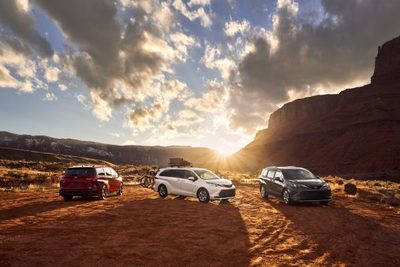Hybrids Still A Big Part Of Toyota's Future
Latin for “prior,” the Prius was, at its inception in 2000, always destined to be the predecessor of a new generation of hybrid vehicles. Now 20 years later, it’s clear the car was aptly named. Toyota has been at the forefront of hybrid technology ever since, selling more than 15 million hybrid electric vehicles as of January 2020.
These numbers underscore how hybrid technology has become a core strategy for Toyota. The automaker envisioned a world where a fuel-efficient engine was not the alternative, but rather the norm. And with annual global sales of electric vehicles (EVs) at approximately 1.5 million cars, Toyota became the first automaker to establish global mass production of EVs, enabling the evolution of a diverse fleet of hybrids with something for every customer.
Now, with the growth of the lineup comes a shift in perception. Whereas hybrids were formerly the standard bearers for environmental stewardship, they are now thrilling experiences in their own right. Quicker and more desirable, with strong design, new features and impressive performance beginning to take shape in many alternative-fuel powered models, Toyota’s hybrid vehicles are surging ahead, no longer considered a rolling science project.
To gain insights into the evolution of hybrid technology and what it means for the future of Toyota’s electrification strategy, we turned to Doug Murtha, group vice president, Corporate Planning and Strategy, and Heather Updegraff, general manager, Vehicle Marketing & Communications. Murtha and Updegraff have not only helped steer the course of the hybrid to this point, they are on the leading edge of where the industry-changing technology is headed next.
More Than Just Fuel Economy
The new revolution in hybrid driving begins with power. Says Murtha, “If we’re going to sell across the model line-up, it can’t just be about fuel economy.”
Until now, fast zero-to-60 acceleration or robust torque were not expected from the hybrid driving experience. When the Prius was introduced to the world, the name became synonymous with going green, not pulling Gs. And while this reputation appealed to ecofriendly drivers, Toyota wanted to diversify its hybrid offerings.
“Many people want to take care of the environment, but also need a big car to handle family and gear. So, we moved hybrid into other vehicles so that people didn’t feel like they had to make a choice between taking care of the environment or taking care of their own needs,” says Updegraff.
When Toyota began developing hybrid versions of vehicles like the Camry or Highlander, the goal was to produce cars that drove farther using less fuel. However, the company quickly realized that in order for this technology to really appeal to the average driver, its products’ performance needed to compete with gas engines.
“Drivers may want to get good MPG, but still feel the power of the engine,” says Updegraff. “So we’ve been developing different types of hybrid engines, including the RAV4 Hybrid, which is the highest-performing RAV in the RAV family.” In June of 2020, RAV4 Hybrid sales were up nearly 90%, accounting for slightly more than half of RAV4’s total June sales, the first time ever a hybrid has outsold its gas counterpart.
Like other new-generation hybrids, the RAV4 Hybrid is prized for its pick-up, what Updegraff calls “the feel off the line.” Murtha agrees: “What’s selling is acceleration.” In fact, many dealers cite the vehicle’s get-up-and-go rather than fuel economy as customers’ main reason for purchasing it.
“Some of the dealers basically don’t tell the customer it’s a hybrid when they send them out for a test drive,” says Murtha. “And when they come back and they love the acceleration and all these different things about it, then they’ll tell them.”
Building a Diverse Lineup
When searching for a new vehicle, drivers expect exciting, new features that will suit their lifestyle. Do they take frequent road rips? Are they looking for a smooth, powerful ride? Do they need space for camping or carpooling? It became clear that Toyota needed to develop hybrids that move quicker, travel farther and feel stronger. And there is something else driving the momentum of hybrids. Toyota has set ambitious sales goals designed to foster a culture of hybrids here and around the world. By 2025, the company intends 25% of new vehicle sales in the U.S. to be hybrid and 50% globally to be electrified, which includes plug-in hybrid, fuel-cell electric, battery-electric, and hybrid vehicles.
Therefore, the entire Toyota lineup is filling out with hybrid options, each one adding design, technology, engineering and safety features. Customer demand is high, including for the Toyota hallmark, the sedan. The Mirai was the first production hydrogen fuel-cell electric vehicle (FCEV) offered for sale to retail customers in North America. And small wonder: Mirai means “future” in Japanese. The all-new 2021 Mirai, with a 30% target range increase, will be on sale by the end of the year. Hybrid editions of Corolla, Camry and flagship sedan, the Avalon, are strong performers, with the all-new 2020 Corolla and Corolla Hybrid winning the 2020 Green Car of the Year® award.
Vehicles that move quicker, like the RAV4 Hybrid, demonstrate their evolved state as soon as you press your foot on the pedal. But it’s still important for some drivers to stay close to the original mission of the hybrid by maxing those MPGs. In an era interested in electrification, yet clamoring to go the distance, hybrids’ ability to combine a gas and electric engine addresses both needs. As Updegraff says, “Range anxiety is not an issue.” Meanwhile Toyota is creating stronger vehicles that have added torque, developing cars that can carry a solid load — something usually looked for in pickup trucks. These benefits are exactly what prospective buyers can expect in the coming generations of Toyota.
In fact, the company recently announced two new all-hybrid vehicles: Sienna minivan and the Venza SUV, both designed with a modernized look and powered with a fuel-frugal electric hybrid powertrain. Fittingly, the Sienna is modeled after Japan’s Shinkansen bullet train, easily a first for a minivan.
“The Sienna and the Venza show that hybrid’s not an offshoot fuel economy story, it’s the core product,” says Murtha. “It can be everything you need it to be.”
On the Horizon
That “core product” will continue to be on the move, speeding towards the future. When Toyota Motor Corporation announced that by 2025, every vehicle in the lineup will have an electrified alternative, this is very much the world the company envisioned—maximum choice While the hybrid powertrain will certainly be present in many new models, the company will continue to develop cars that utilize a variety of alternate fuel sources, such as fuel cell (FCVs), plug-in and battery electric vehicles. The 2025 goal, says Murtha, “is true to our history.” This multifaceted approach will help Toyota optimize the potential of future cars powered by alt-fuel sources, allowing them to create cars that move faster, travel farther and feel stronger, while also reducing emissions. Says Murtha, “This is our next shock to the system and challenge to the industry.”
For example, FCEVs utilize a fuel cell instead of, or in combination with, a battery to power the on-board electric motor. Toyota has long believed that hydrogen fuel cell technology could be a zero-emission solution for a wide array of vehicles. The Mirai represents approximately 75% of fuel cells sold in the U.S. There are currently approximately 42 hydrogen stations in California with several more in development.
In addition to cars, the company is partnering with the Port of Los Angeles to establish a fuel cell electric technology network for freight to move goods from shore to shore. The project includes 10 new zero-emission fuel cell electric Class 8 hydrogen-powered on-road trucks to help transport cargo from the Port of Los Angeles.
A Hybridized World
Since the debut of the Prius, Toyota has embraced hybrid as a key strategy and embedded its ideals into each car it develops. In the process, the company is harnessing a wealth of fuel-source discoveries that could very well lead to the next generation of automobiles. Vehicles powered by alternate fuel sources can do more than reduce carbon emissions, and Toyota has set out to push the limits on what these cars can achieve.
“We’re placing a bet on a technology,” says Murtha. “But we think that hybrid eventually becomes the future, where we look back and everything is largely hybridized.” Or, as Updegraff says, “Cars evolve along with the society they mirror.”



